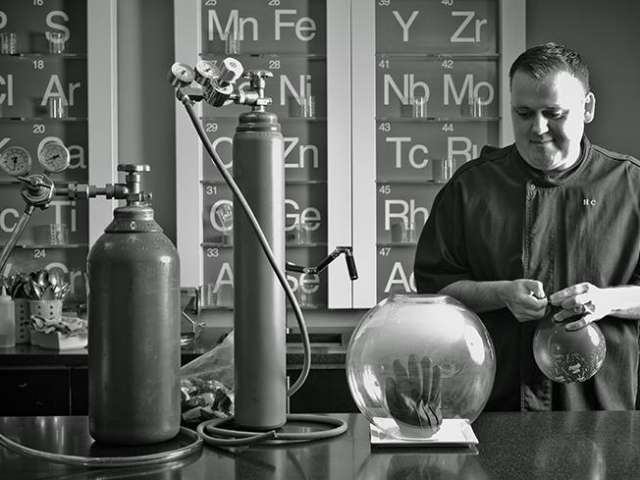A Requiem For Molecular Gastronomy Pioneer Moto, Closing In February
By Anthony Todd in Food on Jan 25, 2016 3:06PM
Last Friday afternoon at 4:16 p.m., in what was either a perfect example of “taking out the trash day” or a total coincidence, a release went out announcing that Moto, the famed pioneering molecular gastronomy restaurant, would soon be no more. The space will be sold to the Alinea restaurant group, and the restaurant will close on Feb. 14. Not included in the release (but sent to me by a tipster) is the information that Berrista, the progressive coffee shop also controlled by the Moto folks, now has a “for lease” sign in its window.
This sad turn of events comes as no real surprise, since the owner and driving force behind Moto (and Berrista), Chef Homaro Cantu, died last April. But whenever a restaurant of this stature disappears into the annals of food history, it’s worth a moment of reflection.
Moto, in its heyday, was a restaurant unlike any other in Chicago. One-third restaurant, one-third performance art piece and one-third science lab, Moto wowed and confused diners at every turn. What Chicago foodie could forget being taken into the basement kitchen, told to don goggles and watch as a course of their meal was incinerated by an industrial laser before their eyes?

There are few restaurants where every single meal is memorable, but Moto was one of them. Note that I did not say “where every single meal is good” —Moto had its ups and downs. For every memorably blow-your-mind dish (like the perfect replica of a Cuban cigar crafted out of bread, collard greens and black pepper), there was another that was totally disastrous. I have a strong memory of a particular revolting concoction involving liquefied lettuce combined with tomato that almost made me want to get up from the table and leave. But still, I went back again and again.
Why? Well, in addition to the always-memorable food, Moto was a great place to catch a glimpse of what might be (but probably wasn’t) coming next, a sort of EPCOT of future food. Would diners necessarily be eating every meal off of anti-griddles, like the servers promised? Would menus really be edible in the future? Probably not, but if they happened to be right, you wanted to say that you saw it first. How many restaurants worked with NASA, had an indoor farm in the basement and had a chef that boasted a long string of patents? None, really. While Alinea, which Moto was inevitably compared to, is an exercise in quiet perfection (with a backdrop of experimentation), Moto was a mad scientist's wacky playroom.

Innovations abounded at Moto. It was one of the first restaurants in the city to swap chefs and servers, to rotate employees through different jobs. It’s the first place I remember having really creative drink pairings that didn’t begin and end with wine. The restaurant had a fancy computer control system, similar to one found at a fast food restaurant. The chef did a TED talk! And the service was inevitably some of the best in the city, which I have to believe led to their Michelin star almost as much as the food.
A date and I who regularly dined at Moto would play a game every time we went: Could we get up from our seat, pass the curtained hallway to the kitchen (where the servers hid between courses) and make it across the room to the bathroom, without someone popping out from nowhere to courteously hold open the door for us? Over a three hour meal, there were plenty of opportunities for games like this (if you drop a napkin, how long will it take for them to notice?) but the servers inevitably won.
I’ve already written extensively about Homaro Cantu himself and his visions, sometimes magical and sometimes crazy. It’s rare for an innovative enterprise centered on a charismatic founder to survive the founder’s death. And besides the love felt for Cantu by many in the food scene, it’s especially sad because he had big plans for the restaurant in the future. He told me (in secret, but it’s a bit late for that now), of plans to sell the original space to the Alinea folks, to move Moto to the old Charlie Trotter’s building, to turn Trotter’s famed TV studio into a combination research lab and broadcast center, to employ a whole staff of food scientists. Smaller innovations were in his brain too, like a plan to allow diners to control the lighting at each individual seat to get perfect photographs. While the sale of the spot to Kokonas and Achatz happened, it looks like the rest of these ideas died with Cantu.
There were notable flops that came from this group as well. Every time Cantu tried to open another spot and capture the magic again, it didn’t quite work; note the failed Otom, Ing and Berrista. I always believed that failure came because the magic was not really in the wacky food, but in the entire experience—especially the experience of talented people who were allowed to try just about anything. In the fine dining fairyland of Moto, the whole thing worked, but anywhere else, it didn’t. In the end, the first restaurant was also the last restaurant, and Moto will be the one we all remember.
If you want to get one more taste of the restaurant, they’re open for another few weeks. I prefer to reminisce on my many memorable meals at this important place (and my many memorable encounters with its patriarch) and remember that, occasionally, hyperbole aside, there comes a dining establishment that really does change the way you think about food and its possibilities.
